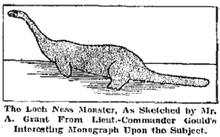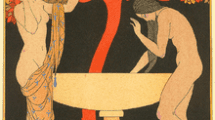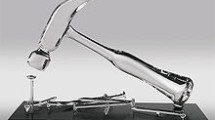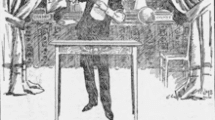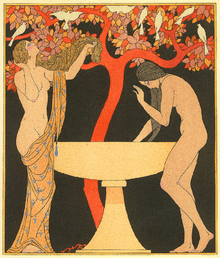Alleged creature in Scotland
The Loch Ness Monster (Scottish Gaelic: Uilebheist Loch Nis[3]), affectionately known as Nessie, is a creature in Scottish folklore that is said to inhabit Loch Ness in the Scottish Highlands. It is often described as large, long-necked, and with one or more humps protruding from the water. Popular interest and belief in the creature has varied since it was brought to worldwide attention in 1933. Evidence of its existence is anecdotal, with a number of disputed photographs and sonar readings.
The scientific community explains alleged sightings of the Loch Ness Monster as hoaxes, wishful thinking, and the misidentification of mundane objects.[4] The pseudoscience and subculture of cryptozoology has placed particular emphasis on the creature.
Origin of the name
In August 1933, the Courier published the account of George Spicer’s alleged sighting. Public interest skyrocketed, with countless letters being sent in detailing different sightings[5] describing a “monster fish,” “sea serpent,” or “dragon,”[6] with the final name ultimately settling on “Loch Ness monster.”[7] Since the 1940s, the creature has been affectionately called Nessie (Scottish Gaelic: Niseag).[8][9]
Sightings
Saint Columba (565)
The earliest report of a monster in the vicinity of Loch Ness appears in the Life of St. Columba by Adomnán, written in the sixth century AD.[10] According to Adomnán, writing about a century after the events described, Irish monk Saint Columba was staying in the land of the Picts with his companions when he encountered local residents burying a man by the River Ness. They explained that the man was swimming in the river when he was attacked by a “water beast” that mauled him and dragged him underwater despite their attempts to rescue him by boat. Columba sent a follower, Luigne moccu Min, to swim across the river. The beast approached him, but Columba made the sign of the cross and said: “Go no further. Do not touch the man. Go back at once.”[11] The creature stopped as if it had been “pulled back with ropes” and fled, and Columba’s men and the Picts gave thanks for what they perceived as a miracle.[11]
Believers in the monster point to this story, set in the River Ness rather than the loch itself, as evidence for the creature’s existence as early as the sixth century.[12] Skeptics question the narrative’s reliability, noting that water-beast stories were extremely common in medieval hagiographies, and Adomnán’s tale probably recycles a common motif attached to a local landmark.[13] According to skeptics, Adomnán’s story may be independent of the modern Loch Ness Monster legend and became attached to it by believers seeking to bolster their claims.[12] Ronald Binns considers that this is the most serious of various alleged early sightings of the monster, but all other claimed sightings before 1933 are dubious and do not prove a monster tradition before that date.[14] Christopher Cairney uses a specific historical and cultural analysis of Adomnán to separate Adomnán’s story about St. Columba from the modern myth of the Loch Ness Monster, but finds an earlier and culturally significant use of Celtic “water beast” folklore along the way. In doing so he also discredits any strong connection between kelpies or water-horses and the modern “media-augmented” creation of the Loch Ness Monster. He also concludes that the story of Saint Columba may have been impacted by earlier Irish myths about the Caoránach and an Oilliphéist.[15]
D. Mackenzie (1871 or 1872)
In October 1871 (or 1872), D. Mackenzie of Balnain reportedly saw an object resembling a log or an upturned boat “wriggling and churning up the water,” moving slowly at first before disappearing at a faster speed.[16][17] The account was not published until 1934, when Mackenzie sent his story in a letter to Rupert Gould shortly after popular interest in the monster increased.[18][17][19][20]
Alexander Macdonald (1888)
In 1888, mason Alexander Macdonald of Abriachan[21] sighted “a large stubby-legged animal” surfacing from the loch and propelling itself within fifty yards of the shore where Macdonald stood.[22] Macdonald reported his sighting to Loch Ness water bailiff Alex Campbell, and described the creature as looking like a salamander.[21]
Aldie Mackay (1933)
The best-known article that first attracted a great deal of attention about a creature was published on 2 May 1933 in The Inverness Courier, about a large “beast” or “whale-like fish”. The article by Alex Campbell, water bailiff for Loch Ness and a part-time journalist,[citation needed] discussed a sighting by Aldie Mackay of an enormous creature with the body of a whale rolling in the water in the loch while she and her husband John were driving on the A82 on 15 April 1933. The word “monster” was reportedly applied for the first time in Campbell’s article, although some reports claim that it was coined by editor Evan Barron.[14][23][24]
The Courier in 2017 published excerpts from the Campbell article, which had been titled “Strange Spectacle in Loch Ness”.[25] “The creature disported itself, rolling and plunging for fully a minute, its body resembling that of a whale, and the water cascading and churning like a simmering cauldron. Soon, however, it disappeared in a boiling mass of foam. Both onlookers confessed that there was something uncanny about the whole thing, for they realised that here was no ordinary denizen of the depths, because, apart from its enormous size, the beast, in taking the final plunge, sent out waves that were big enough to have been caused by a passing steamer.”
According to a 2013 article,[18] Mackay said that she had yelled, “Stop! The Beast!” when viewing the spectacle. In the late 1980s, a naturalist interviewed Aldie Mackay and she admitted to knowing that there had been an oral tradition of a “beast” in the loch well before her claimed sighting.[18] Alex Campbell’s 1933 article also stated that “Loch Ness has for generations been credited with being the home of a fearsome-looking monster”.[26]
George Spicer (1933)
Modern interest in the monster was sparked by a sighting on 22 July 1933, when George Spicer and his wife saw “a most extraordinary form of animal” cross the road in front of their car.[27] They described the creature as having a large body (about 4 feet (1.2 m) high and 25 feet (8 m) long) and a long, wavy, narrow neck, slightly thicker than an elephant’s trunk and as long as the 10–12-foot (3–4 m) width of the road. They saw no limbs.[28] It lurched across the road toward the loch 20 yards (20 m) away, leaving a trail of broken undergrowth in its wake.[28] Spicer described it as “the nearest approach to a dragon or pre-historic animal that I have ever seen in my life,”[27] and as having “a long neck, which moved up and down in the manner of a scenic railway.”[29] It had “an animal” in its mouth[27] and had a body that “was fairly big, with a high back, but if there were any feet they must have been of the web kind, and as for a tail I cannot say, as it moved so rapidly, and when we got to the spot it had probably disappeared into the loch.”[29]
On 4 August 1933 the Courier published a report of Spicer’s sighting. This sighting triggered a massive amount of public interest and an uptick in alleged sightings, leading to the solidification of the actual name “Loch Ness Monster.”[7]
It has been claimed that sightings of the monster increased after a road was built along the loch in early 1933, bringing workers and tourists to the formerly isolated area.[30] However, Binns has described this as “the myth of the lonely loch”, as it was far from isolated before then, due to the construction of the Caledonian Canal. In the 1930s, the existing road by the side of the loch was given a serious upgrade.[14]
Hugh Gray (1933)
Hugh Gray’s photograph taken near Foyers on 12 November 1933 was the first photograph alleged to depict the monster. It was slightly blurred, and it has been noted that if one looks closely the head of a dog can be seen. Gray had taken his Labrador for a walk that day and it is suspected that the photograph depicts his dog fetching a stick from the loch.[31] Others have suggested that the photograph depicts an otter or a swan. The original negative was lost. However, in 1963, Maurice Burton came into “possession of two lantern slides, contact positives from th[e] original negative” and when projected onto a screen they revealed an “otter rolling at the surface in characteristic fashion.”[32]
Arthur Grant (1934)
Sketch of the Arthur Grant sighting.
On 5 January 1934 a motorcyclist, Arthur Grant, claimed to have nearly hit the creature while approaching Abriachan (near the north-eastern end of the loch) at about 1 a.m. on a moonlit night.[33] According to Grant, it had a small head attached to a long neck; the creature saw him, and crossed the road back to the loch. Grant, a veterinary student, described it as a cross between a seal and a plesiosaur. He said he dismounted and followed it to the loch, but saw only ripples.[21][34]
Grant produced a sketch of the creature that was examined by zoologist Maurice Burton, who stated it was consistent with the appearance and behavior of an otter.[35] Regarding the long size of the creature reported by Grant; it has been suggested that this was a faulty observation due to the poor light conditions.[36] Paleontologist Darren Naish has suggested that Grant may have seen either an otter or a seal and exaggerated his sighting over time.[37]
Daily Mirror. London.
^ Holiday, F. W. (1968). The Great Orm of Loch Ness: A Practical Inquiry into the Nature and Habits of Water-monsters. London: Faber & Faber. pp. 30–60, 98–117, 160–173. ISBN 0-571-08473-7.
^ Tim Dinsdale (1973) The Story of the Loch Ness Monster Target Books ISBN 0-426-11340-3
^ “1969 Annual Report: Loch Ness Investigation” (PDF). Archived (PDF) from the original on 26 March 2021. Retrieved 8 July 2009.
^ “The Glasgow Herald – Google News Archive Search”. news.google.com. Archived from the original on 28 October 2021. Retrieved 15 November 2020.
^ New Scientist 40 (1968): 564–566; “Sonar Picks Up Stirrings in Loch Ness”
^ Roy Mackal (1976) The Monsters of Loch Ness page 307, see also appendix E
^ “Photographic image”. Archived from the original on 29 August 2011. Retrieved 18 April 2017.{{cite web}}: CS1 maint: bot: original URL status unknown (link)
^ a b Townend, Lorne (writer/director) (2001). Loch Ness Monster: Search for the Truth.
^ a b c Harmsworth, Tony. Loch Ness, Nessie & Me: Loch Ness Understood and Monster Explained.
^ Scott, Peter; Rines, Robert (1975). “Naming the Loch Ness monster”. Nature. 258 (5535): 466. Bibcode:1975Natur.258..466S. doi:10.1038/258466a0.
^ Lawton, John H. (1996). “Nessiteras Rhombopteryx”. Oikos. 77 (3): 378–380. doi:10.2307/3545927. JSTOR 3545927.
^ a b Dinsdale, T. “Loch Ness Monster” (Routledge and Kegan paul 1976), p.171.
^ Fairbairn, Nicholas (18 December 1975). “Loch Ness monster”. Letters to the Editor. The Times. No. 59,581. London. p. 13.
^ “Loch Ness Monster Shown a Hoax by Another Name”. The New York Times. Vol. 125, no. 43,063. Reuters. 19 December 1975. p. 78.
^ a b c “Martin Klein Home” (PDF). Archived (PDF) from the original on 3 August 2020. Retrieved 24 February 2020.
^ a b Dr. Robert H. Rines. Loch Ness Findings Archived 23 August 2006 at the Wayback Machine. Academy of Applied Science.
^ “Veteran Loch Ness Monster Hunter Gives Up – The Daily Record”. Dailyrecord.co.uk. 13 February 2008. Archived from the original on 24 March 2010. Retrieved 28 April 2010.
^ “Operation Deepscan”. www.lochnessproject.com. Archived from the original on 24 April 2015. Retrieved 29 January 2015.
^ “educational.rai.it (p. 17)” (PDF). Archived (PDF) from the original on 11 March 2018. Retrieved 11 March 2018.
^ a b “What is the Loch Ness Monster?”. Firstscience.com. Archived from the original on 4 June 2009. Retrieved 28 May 2009.
^ Mysterious Creatures (1988) by the Editors of Time-Life Books, page 90
^ “BBC ‘proves’ Nessie does not exist”. BBC News. 27 July 2003. Archived from the original on 28 July 2018. Retrieved 4 April 2010.
^ Gemmell, Neil; Rowley, Ellie (28 June 2018). “First phase of hunt for Loch Ness monster complete”. University of Otago. Archived from the original on 21 April 2019. Retrieved 21 April 2019.
^ “Loch Ness Monster may be a giant eel, say scientists”. BBC News. 5 September 2019. Archived from the original on 6 September 2019. Retrieved 6 September 2019.
^ Weaver, Matthew (5 September 2019). “Loch Ness monster could be a giant eel, say scientists”. The Guardian. Archived from the original on 6 September 2019. Retrieved 6 September 2019.
^ Nickell, Joe (2017). “Loch Ness Solved – Even More Fully!”. Skeptical Inquirer. Committee for Skeptical Inquiry. 41 (6): 59, 61.
^ R. P. Mackal (1976) The Monsters of Loch Ness page 216, see also chapter 9 and appendix G
^ Tim Dinsdale (1961) Loch Ness Monster page 229
^ “Varieties”. Colonial Times. Hobart, Tas.: National Library of Australia. 10 June 1856. p. 3. Archived from the original on 28 October 2021. Retrieved 16 September 2013.
^ “Loch Ness Monster may be a giant eel, say scientists”. BBC News. BBC. 5 September 2019. Archived from the original on 6 September 2019. Retrieved 9 September 2019.
^ “New DNA evidence may prove what the Loch Ness Monster really is”. www.popsci.com. 6 September 2019. Archived from the original on 11 September 2019. Retrieved 10 September 2019.
^ News, Tom Metcalfe-Live Science Contributor 2019-09-09T15:53:19Z Strange (9 September 2019). “Loch Ness Contains No ‘Monster’ DNA, Say Scientists”. livescience.com. Archived from the original on 10 September 2019. Retrieved 10 September 2019.
^ Knowles. “The Loch Ness Monster is still a mystery”. The Washington Post. Archived from the original on 22 September 2019.
^ “National Geographic News”. News.nationalgeographic.com. Archived from the original on 20 July 2009. Retrieved 28 May 2009.
^ “‘River Monsters’ Finale: Hunt For Loch Ness Monster And Greenland Shark (Video)”. The Huffington Post. 28 May 2013. Archived from the original on 2 April 2015. Retrieved 28 December 2014.
^ “Scientist wonders if Nessie-like monster in Alaska lake is a sleeper shark”. Alaska Dispatch News. 3 May 2012. Archived from the original on 23 January 2015. Retrieved 5 March 2015.
^ “‘Alaska lake monster’ may be a sleeper shark, biologist says”. Yahoo! News. 9 May 2012. Archived from the original on 5 March 2016. Retrieved 14 January 2017.
^ “Loch Ness Monster ‘Most Likely Large Catfish'”. Sky News. Archived from the original on 17 July 2015. Retrieved 17 July 2015.
^ “Nessie hunter believes Loch Ness monster is ‘giant catfish'”. scotsman.com. Archived from the original on 18 July 2015. Retrieved 17 July 2015.
^ “Loch Ness Monster is just a ‘giant catfish’ – says Nessie expert”. International Business Times UK. 16 July 2015. Archived from the original on 18 July 2015. Retrieved 17 July 2015.
^ R. Binns (1983) The Loch Ness Mystery Solved plates 15(a)-(f)
^ R. Binns (1983) The Loch Ness Mystery Solved plates 16–18
^ Daily Mirror 17 August 1933 page 12
^ Burton, Maurice (1982). “The Loch Ness Saga”. New Scientist. 06–24: 872.
^ Burton, Maurice (1982). “The Loch Ness Saga”. New Scientist. 07–01: 41–42.
^ Burton, Maurice (1982). “The Loch Ness Saga”. New Scientist. 07–08: 112–113.
^ “Movement of Water in Lakes: Long standing waves (Seiches)”. Biology.qmul.ac.uk. Archived from the original on 31 May 2009. Retrieved 28 May 2009.
^ Muir-Wood, Robert; Mignan, Arnaud (2009). “A Phenomenological Reconstruction of the Mw9 November 1st 1755 Earthquake Source”. In Mendes-Victor, Luiz A.; Sousa Oliveira, Carlos; Azevedo, João; Ribeiro, António (eds.). The 1755 Lisbon Earthquake: Revisited. Springer. pp. 130, 138. ISBN 978-1-4020-8608-3.
^ Bressan, David (30 June 2013). “The Earth-shattering Loch Ness Monster that wasn’t”. Scientific American Blog Network. Retrieved 12 April 2022.
^ W. H. Lehn (1979) Science vol 205. No. 4402 pages 183–185 “Atmospheric Refraction and Lake Monsters”
^ Lehn, W. H.; Schroeder, I. (1981). “The Norse merman as an optical phenomenon”. Nature. 289 (5796): 362. Bibcode:1981Natur.289..362L. doi:10.1038/289362a0. S2CID 4280555.
^ “Seismotectonic Origins of the Monster of Loch Ness”. Gsa.confex.com. Archived from the original on 15 May 2010. Retrieved 28 May 2009.
^ Sjögren, Bengt (1980). Berömda vidunder (in Swedish). Settern. ISBN 91-7586-023-6.
^ Aberdeen Weekly Journal, Wednesday, 11 June 1879 “This kelpie had been in the habit of appearing as a beautiful black horse… No sooner had the weary unsuspecting victim seated himself in the saddle than away darted the horse with more than the speed of the hurricane and plunged into the deepest part of Loch Ness, and the rider was never seen again.”
^ Tim Dinsdale (1975) Project Water Horse. The true story of the monster quest at Loch Ness (Routledge & Kegan Paul) ISBN 0-7100-8030-1
^ Watson, Roland,The Water Horses of Loch Ness (2011) ISBN 1-4611-7819-3
^ “Invention of Loch Ness monster”. The Irish Times. 1 January 2009. Archived from the original on 27 December 2011. Alt URL Archived 13 November 2013 at the Wayback Machine
^ “Birth of a legend: Famous Photo Falsified?”. Pbs.org. Archived from the original on 4 June 2011. Retrieved 28 May 2009.
^ “Loch Ness ‘Monster’ Is an April Fool’s Joke”. The New York Times. 2 April 1972. Archived from the original on 24 June 2021. Retrieved 19 June 2021.
^ a b “Loch Ness Monster Hoaxes”. Museumofhoaxes.com. Archived from the original on 21 April 2010. Retrieved 28 April 2010.
^ “Loch Ness monster: The Ultimate Experiment”. Crawley-creatures.com. Archived from the original on 3 May 2008. Retrieved 28 May 2009.
^ “Nessie swims in Loch for TV Show”. BBC News. 16 August 2005. Archived from the original on 29 August 2007. Retrieved 12 August 2012.
^ R. J. Binns (1983) The Loch Ness Mystery Solved, page 22
^ “Why the Loch Ness Monster is no plesiosaur”. New Scientist. 2576: 17. 2006. Archived from the original on 23 February 2007. Retrieved 8 April 2007.
^ “Legend of Nessie – Ultimate and Official Loch Ness Monster Site – About Loch Ness”. www.nessie.co.uk. Archived from the original on 29 September 2018. Retrieved 31 October 2007.
^ Roy P. Mackal (1976) The Monsters of Loch Ness, page 138
^ The Times 9 December 1933, page 14
^ R. P. Mackal (1976) The Monsters of Loch Ness, pages 138–9, 211–213
^ Holiday, F.T. The Great Orm of Loch Ness (Faber and Faber 1968)
^ R. P. Mackal (1976) The Monsters of Loch Ness pages 141–142, chapter XIV
Bibliography
Bauer, Henry H. The Enigma of Loch Ness: Making Sense of a Mystery, Chicago, University of Illinois Press, 1986
Binns, Ronald, The Loch Ness Mystery Solved, Great Britain, Open Books, 1983, ISBN 0-7291-0139-8 and Star Books, 1984, ISBN 0-352-31487-7
Binns, Ronald, The Loch Ness Mystery Reloaded, London, Zoilus Press, 2017, ISBN 9781999735906
Burton, Maurice, The Elusive Monster: An Analysis of the Evidence from Loch Ness, London, Rupert Hart-Davis, 1961
Campbell, Steuart. The Loch Ness Monster – The Evidence, Buffalo, New York, Prometheus Books, 1985.
Dinsdale, Tim, Loch Ness Monster, London, Routledge & Kegan Paul, 1961, SBN 7100 1279 9
Harrison, Paul The encyclopaedia of the Loch Ness Monster, London, Robert Hale, 1999
Gould, R. T., The Loch Ness Monster and Others, London, Geoffrey Bles, 1934 and paperback, Lyle Stuart, 1976, ISBN 0-8065-0555-9
Holiday, F. W., The Great Orm of Loch Ness, London, Faber & Faber, 1968, SBN 571 08473 7
Perera, Victor, The Loch Ness Monster Watchers, Santa Barbara, Capra Press, 1974.
Whyte, Constance, More Than a Legend: The Story of the Loch Ness Monster, London, Hamish Hamilton, 1957
Documentary
External links

